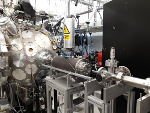| | 1 | = Laser-driven ion acceleration: emerging mechanisms and progress towards biomedical applications - Marco Borghesi (Queen's University Belfast) = |
| | 2 | |
| | 3 | * [#abstract Abstract] |
| | 4 | * [raw-attachment:2021-05-26-Borghesi.pptx Slides] |
| | 5 | * Details: |
| | 6 | |
| | 7 | Date: 26 May 2021\\ |
| | 8 | Time: 15:00 \\ |
| | 9 | Zoom link: https://ukri.zoom.us/j/94424786740 |
| | 10 | |
| | 11 | == Abstract == |
| | 12 | [=#abstract] |
| | 13 | There is growing interest in laser-based, all-optical technologies for particle acceleration, due to their intrinsically compact nature, and to the unique properties of the beams produced through these techniques. The prospect for future clinical application has, in particular, been a strong motivation for research in acceleration of protons and heavier ions. Amongst a number of projects worldwide, the EPSRC funded A-SAIL consortium has in recent years engaged in a range of activities aimed to advance laser ion acceleration processes towards future medical applications. |
| | 14 | The talk will review some of our group’s recent contributions to this research. |
| | 15 | In experiments at the Central Laser facility of the Rutherford Appleton Laboratory, we have explored advanced acceleration mechanisms employing ultrathin foils, where not only protons, but also carbon ions can be efficiently energised by the laser’s Radiation Pressure ![1,2]. Additionally, we have developed target-based techniques for beam transport, collimation and post-acceleration of laser-driven protons ![3], which allow the production of low-divergence, high-flux collimated beamlets with energies up to 50-70 MeV. Finally, we have developed arrangements for irradiating biological samples, on a single shot basis, to Gy-level doses at dose rates exceeding 109 Gy/s, opening up to investigation this novel regime of radiobiology ![4-6]. |
| | 16 | |
| | 17 | ![1] C. Scullion et al, Phys. Rev. Lett.,119, 054801 (2017)\\ |
| | 18 | ![2] A. McIlvenny et al, Plasma Phys. Control Fusion, 62, 054001 (2020)\\ |
| | 19 | ![3] S. Kar et al, Nature Comm., 7, 10792 (2016)\\ |
| | 20 | ![4] H. Ahmed et al, Sci. Reports, 11, 699 (2021)\\ |
| | 21 | ![5] G. Milluzzo et al, J. Phys: Conf. Ser., 1596, 012038 (2020)\\ |
| | 22 | ![6] F. Hanton et al, Sci. Reports, 9, 4471 (2019) |
| | 23 | |
